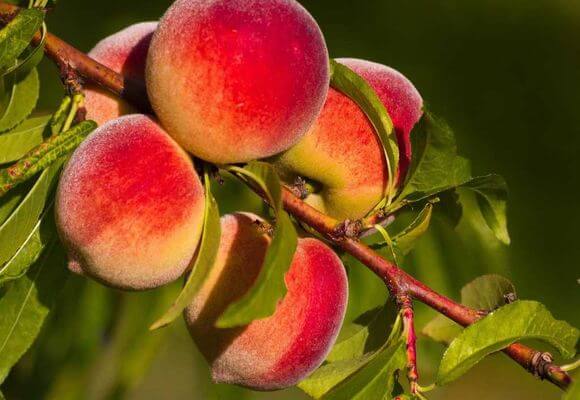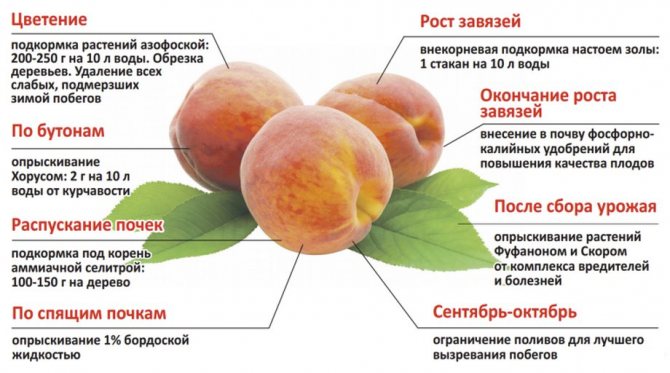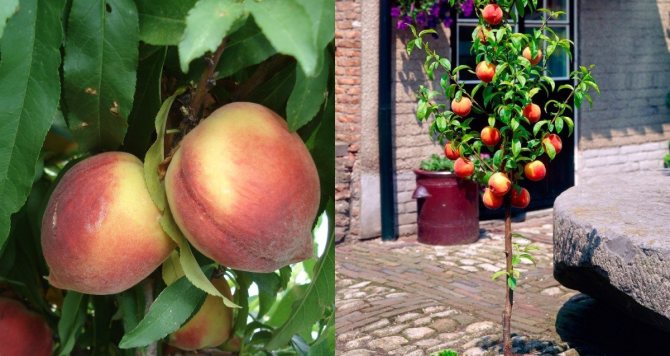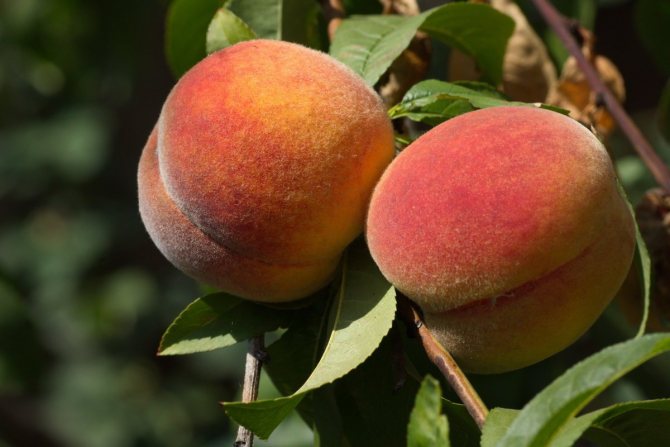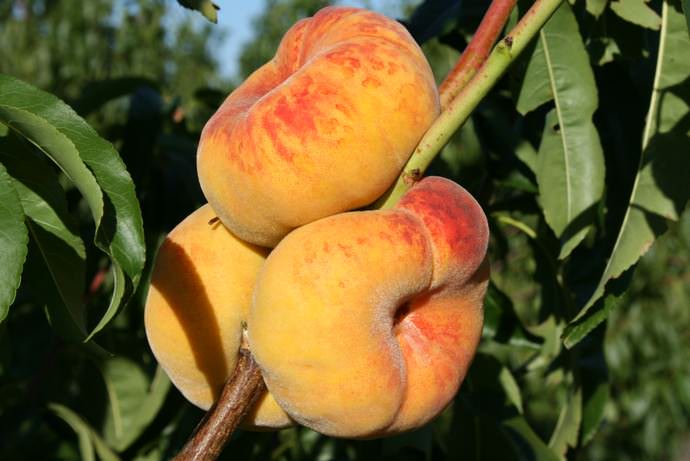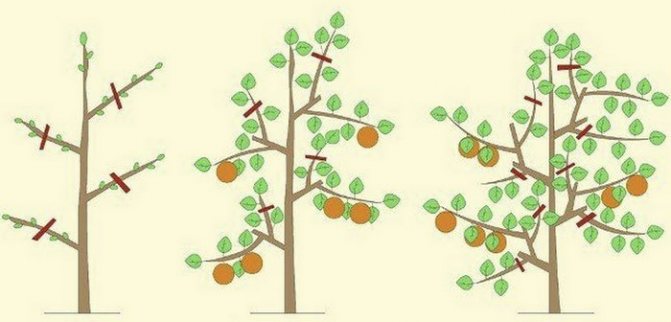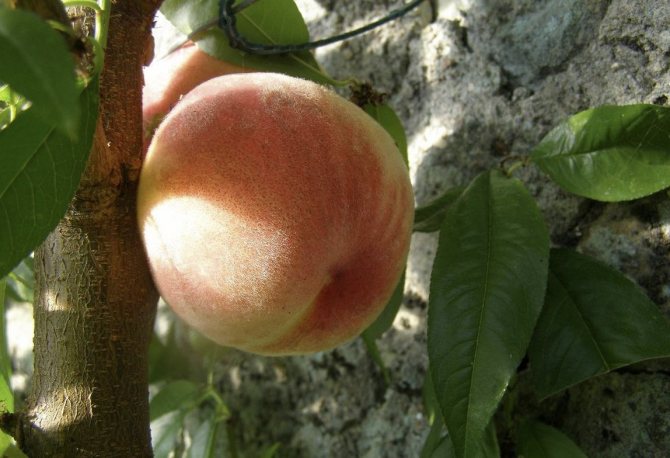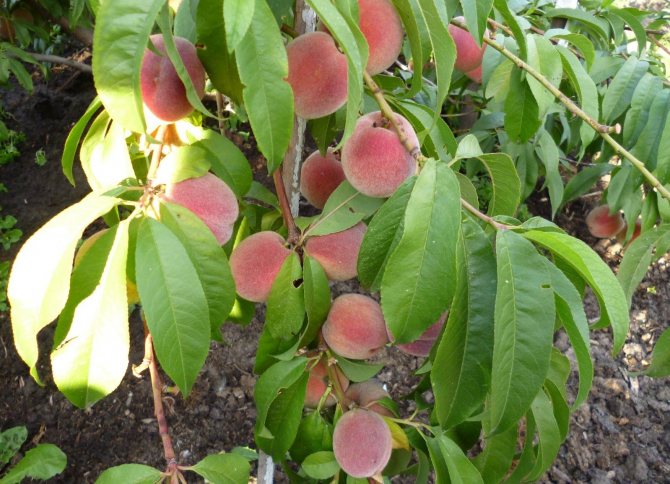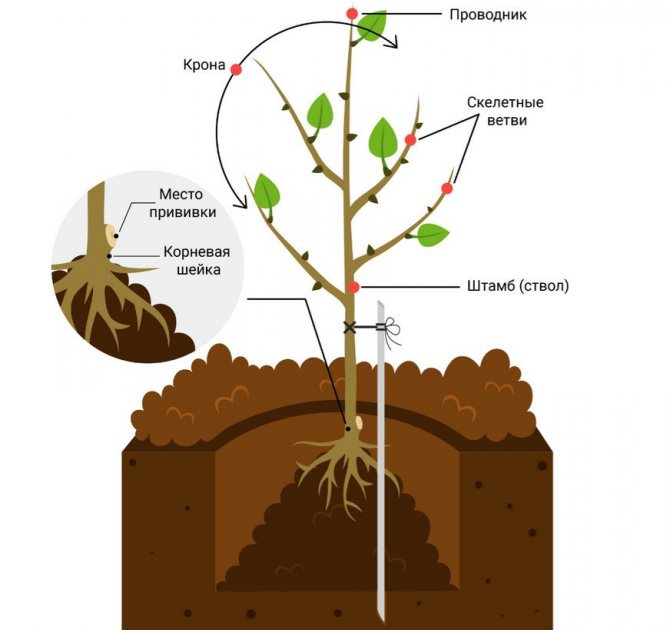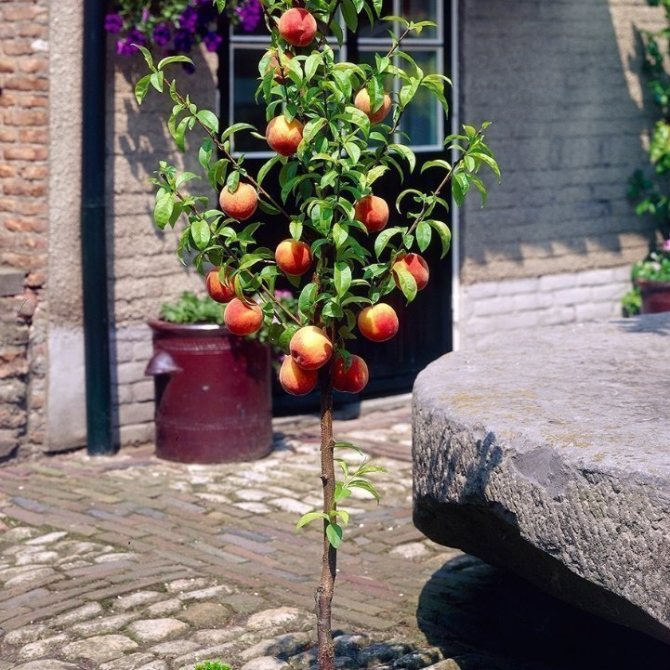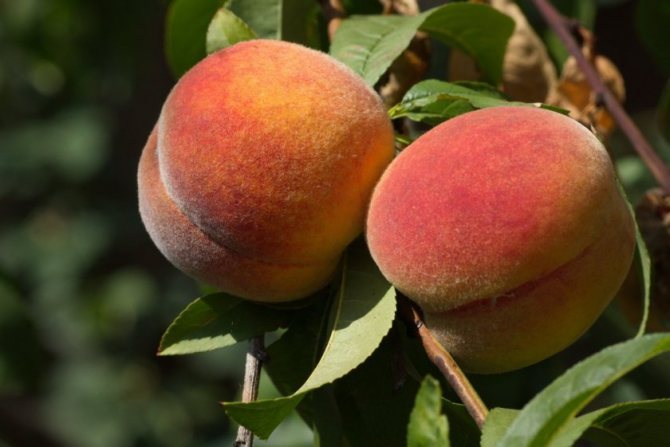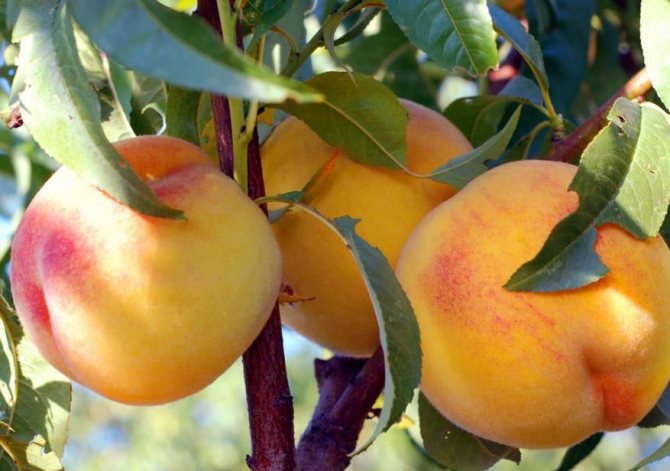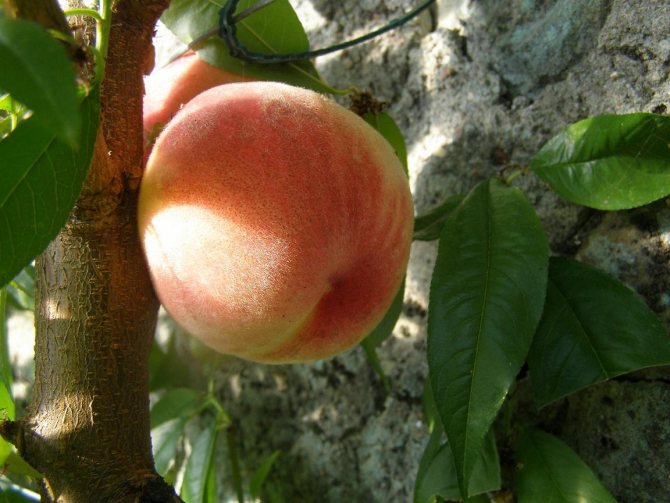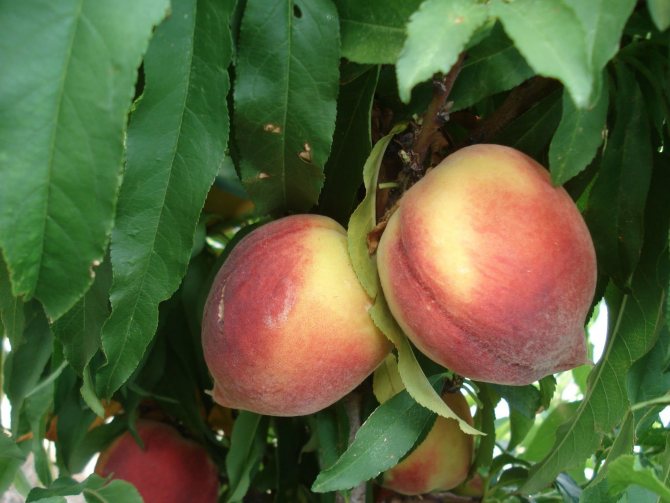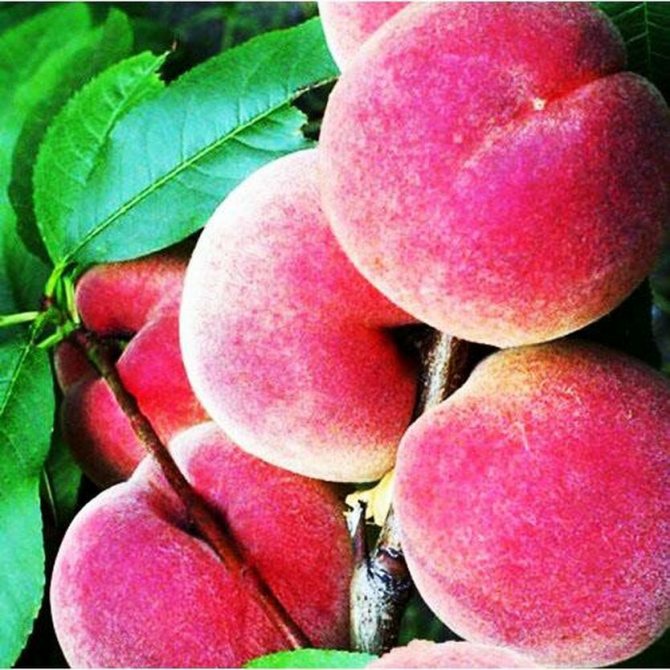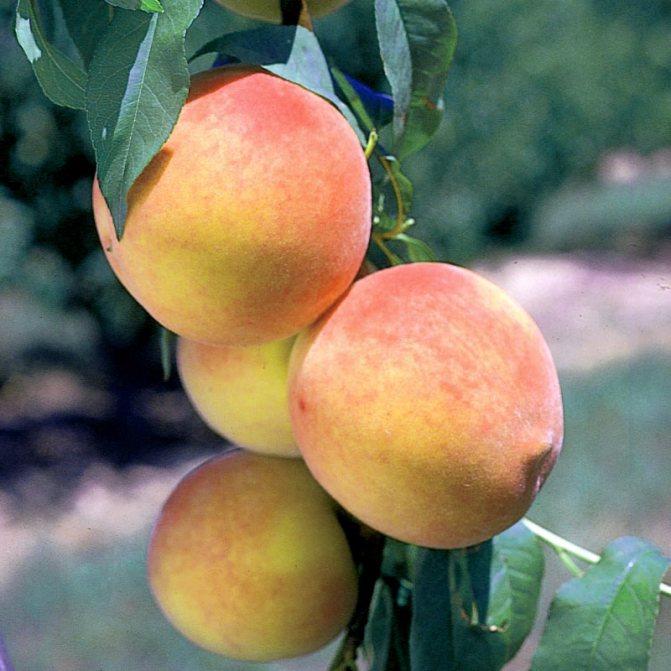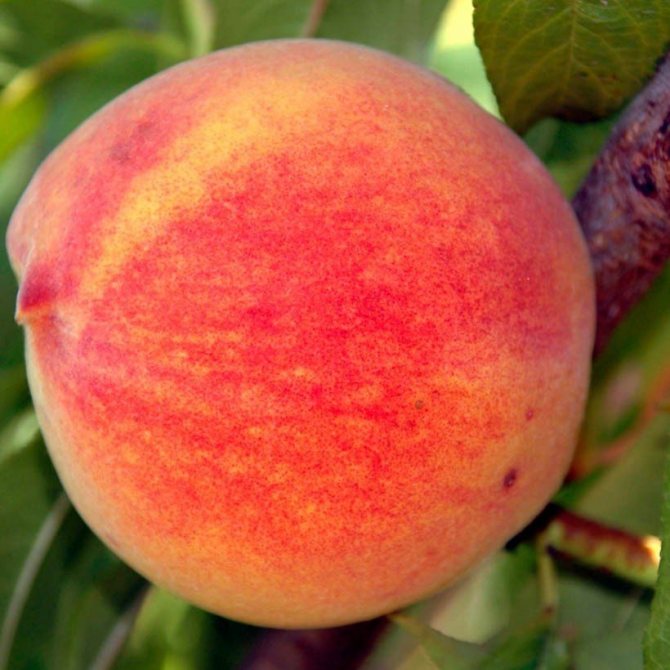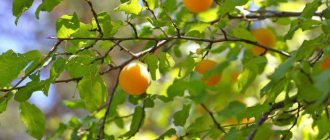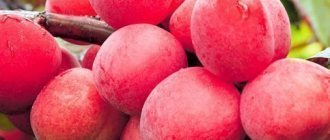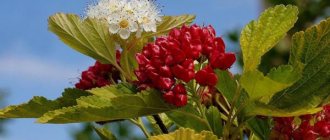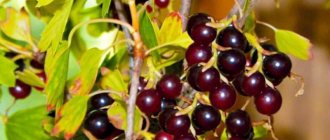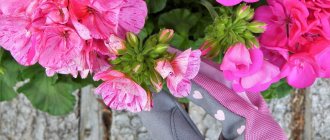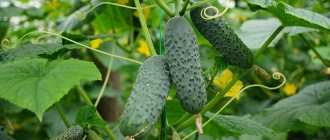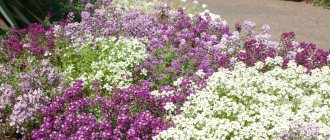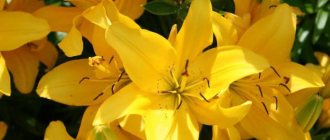- Species characteristic
- Columnar peach varieties
- Growing
- Landing rules
- Care basics
Among the many varieties of peaches, there are also quite exotic ones. One of these species is the columnar peach. It got its name from its unusual crown shape. It is grown not only for the purpose of harvesting, but also to decorate the site.
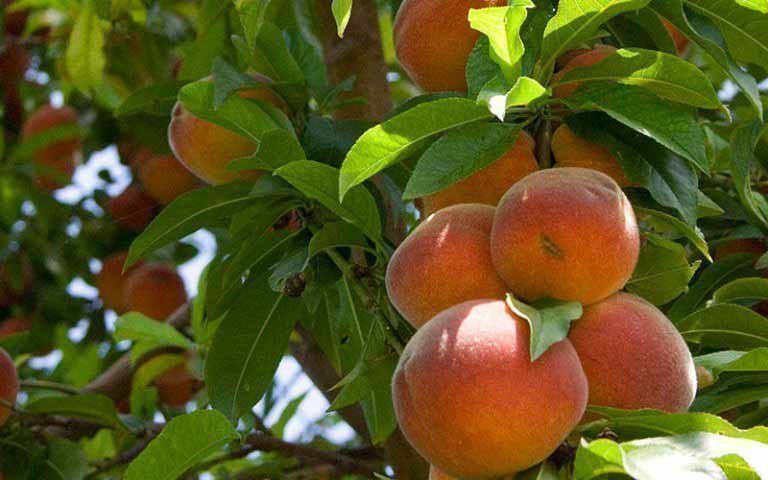
General characteristics and description of columnar peaches
This fruit variety is a dwarf plantation, the height of which is no more than 1.5 meters. Its crown is cylindrical, 40-60 centimeters wide. A miniature fruit tree looks spectacular not only in group plantings, but also when grown in single copies. It looks especially beautiful in the flowering phase and when the fruits reach their consumer maturity.
In the columnar peach, the lateral shoots do not form branches, their growth is directed directly from the central conductor. It is this feature that explains the fact that the fruits are very close to the trunk, surrounding it. Their weight can reach up to 250 grams. Taste qualities are high: the pulp is juicy, moderately dense, sweet and with a pronounced aroma.
They contain vitamins, essential oils, saccharides, vegetable acids and mineral compounds.
The leaf mass is distinguished by a dark green color. The shape of the plates is oval-oblong, the ends are pointed. The flowering stage occurs in mid-spring, the inflorescences are distinguished by a pale pink color. From one columnar peach, it is possible to collect from 6 kilograms of fruit. Winter hardiness is excellent, up to -40 degrees.
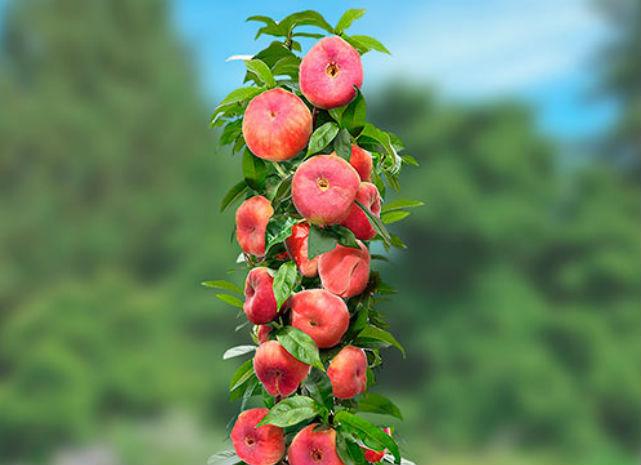

Planting seedlings
In order for the future tree to take root well and give a tasty and large harvest, it is important to plant it correctly, following the following scheme:
- A pit is dug under each seedling, the diameter of which is 70-100 cm, and the depth is 80 cm;
- The next step is to fertilize the planting site with chicken droppings or humus, which are introduced into the prepared pits. For the earth to absorb the recharge, it should take about 7-14 days;
- The indent of one row from the other is 1 meter. The distance between the seedlings is 50 cm;
- Hills formed in the pit after manure was poured into them - they are covered with fertile soil before planting;
- Next, we place our trees in the pits, carefully spreading their roots;
- We fill the holes with earth, and we tie the seedlings onto pegs previously driven into the pits;
- We make abundant watering.
Advantages and disadvantages
Experienced gardeners distinguish among the positive characteristics of the miniature peach tree:
- does not take up much space on the site;
- does not shade other fruit and berry crops;
- has sufficient frost resistance;
- It does not require special care;
- has an increased immunity to the main ailments, pests;
- high consumer qualities of fruits;
- good performance indicators;
- does not require additional pollination (self-fertile).
But there are also some disadvantages to the dwarf peach, among which:
- short fruiting period;
- the need for frequent updating of landings;
- high cost of seedlings.
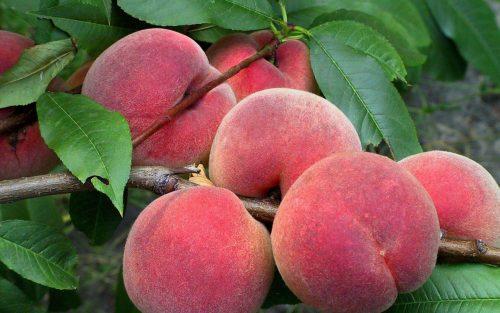

Fruit history and health benefits
The homeland of the hybrid is the United States.In order to breed it, American breeders had to cross the Gold King and Red King varieties.
The location of the experiment is California. 1961 is the time of the appearance of this nectarine. This fruit is unique.
Its appearance is similar to that of a smooth peach. Has a surprisingly pleasant taste. The fragrant pulp contains a huge complex of substances that help maintain human health. That is why nectarine is a welcome guest of any garden plot.
Often summer residents are faced with the problem of placing this tree in their garden. The small size of the plot does not allow planting nectarines in the amount that we would like. But do not give up.
Popular varieties
The list of the best varieties of columnar peach includes:
- The gardener's totem. The plant is distinguished by medium vigor (height - no more than 1.7 meters), large-fruited (up to 290 grams) and high yield. Up to 14 kilograms of rounded and slightly pressed fruits are harvested from one tree. They attract attention with their red blush and incredibly juicy pulp. The crop is not afraid of transportation and retains its marketable qualities for a long time.
- Steinberg. The plant grows and develops well regardless of the amount of sunlight. It does not exceed 2 meters in height. The fruit weighs 155 grams, they are juicy and tasty. The color is yellow-orange, there are places with a raspberry tint.
- Anniversary of the capital. The ripening period is early, the height of the tree is 1.5 meters, the yield is up to 12 kilograms. The weight of one fruit is 230-250 grams, the shape is round. The tree stands out for its resistant immunity to fungal infections, parasitic individuals.
- Golden triumph. With a tree height of 1.4 meters, its yield indicators are 10-12 kilograms of tasty fruits. The weight of one is 280 grams. The color of the fruit is red, the pulp is juicy, the aroma is pronounced. The columnar peach variety has good resistance to cold, drought and most major diseases.
- Honey. The plant is mid-season, tall (up to 2 meters), its productivity is at the level of 10-12 kilograms. Fruit weight, on average, is 180 grams. Taste characteristics are high: honey taste, sweet and juicy pulp. The color is yellow-red outside, yellow inside.
See also
Description and characteristics of varieties and types of peaches, selection rules for regionsRead
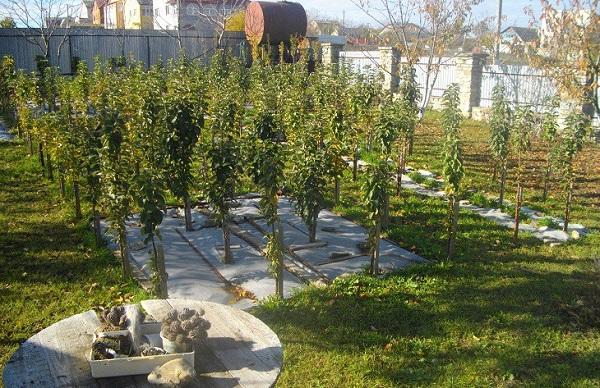

The best varieties of columnar nectarine
Despite the fact that there are not many columnar varieties of peach and nectarine today, gardeners still have a choice.
| Variety name | Description and varietal characteristics | Gardeners reviews |
| Nectarine "Fantasy" | A low and very compact plant with a height of no more than two meters and a crown diameter of about 0.5 m. Fruits are even, round, bright orange with a burgundy blush, weighing up to 175 g. Enters fruiting a couple of years after planting. Immunity to leaf curl. Frost resistance up to -30 ° С | This is one of the most delicious and beautiful varieties of nectarine with a very delicate pulp and easily separable pits. It grows well even with insufficient competent care and does not require high agricultural technology |
| Rubis nectarine | The plant is 1.2-1.5 m high, blooming profusely with pink flowers. Fruits are large in size, ruby-purple in color with amber pulp. Ripen in July | Reviews characterize the variety as large-fruited and productive. Can be grown both indoors and outdoors. Differs in unpretentious care |
Growing features
To obtain the desired result, you need to know the basic subtleties of the process of planting columnar peaches.
Timing
The timing of planting dwarf peaches directly depends on the climatic conditions in a particular region. In the southern regions, seedlings should be determined for a permanent place in the fall, but in the northern regions - in the spring.Young plantings need time to adapt, rooting, so that they can painlessly survive sub-zero temperatures. It is better to purchase annual seedlings, paying attention to the condition of the root mass.
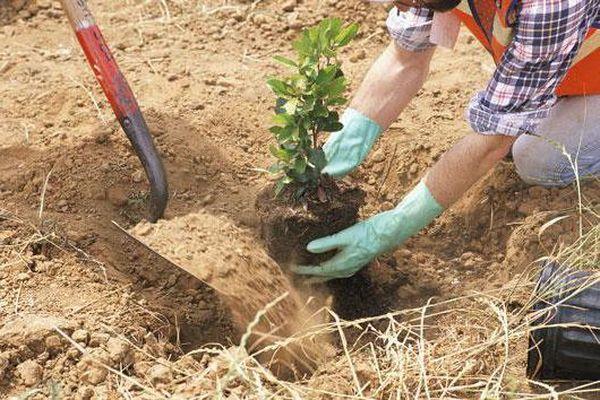

Preparing the landing site
In order for the planted trees to be comfortable and to grow faster, you need to choose an area with a sufficient level of lighting - sunny.
If you plant in shaded areas, near various buildings, in wetlands, then there is a high probability of developing various diseases, suppressing the general condition of the columnar peach.
Preparatory work should be done in advance, removing all excess vegetation and debris from the site. The place for planting a columnar peach must be dug up, enriched with useful components, adding humus or rotted manure to the soil. If the planting time of the columnar peach is spring, then the preparation should be done in the fall. For an autumn planting, work must be carried out a month in advance.
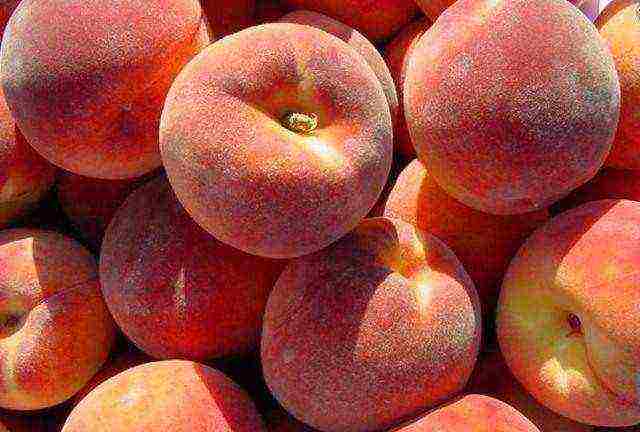

Planting seedlings
The size of the planting pits for planting a columnar peach is determined by its root system. In most cases, the pit is 50 centimeters in diameter, and the depth is in the range of 50-60 centimeters. In order to avoid stagnation of moisture, drainage should be laid on the bottom: brick battle, expanded clay, crushed stone. The thickness of the layer should be 7-10 centimeters; the same layer of fertile soil is poured over the drainage.
To tie a columnar peach into the pit, you need to install a peg made of wood.
Place the columnar peach seedling vertically, straightening its root system. Sprinkle on top with a layer of earth, carefully tamping it in order to exclude the formation of voids in the planting pit. Finally, the columnar peach is watered abundantly (10 liters of water per plant), tied to a support, and mulched.
See also
Description and characteristics of Redhaven peach, history of selection of the variety and growing rulesRead
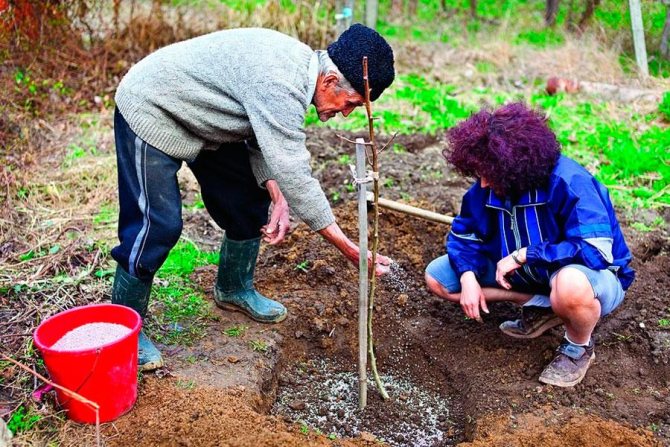

Landing rules
Initially, you should decide on the landing region. This will determine which sort of columnar variety of peaches to give preference to. If this is the southern part of the country, then it is best to plant seedlings in the fall. But in the central or northern region, spring will be the ideal planting time. When determining the place of future landing, pay attention to the fact that it meets the following requirements:
- Peaches, during the growing season, do not perceive drafts and cold well. For this reason - avoid planting them in lowlands, where there will always be a lower temperature;
- Make sure that the tree is protected from wind and drafts in the immediate vicinity of the planting site;
- The site should be illuminated by the sun as much as possible.
Tree care rules
The list of the main measures for the care of the columnar peach includes: the introduction of nutrients, weeding, irrigation, and preventive procedures against diseases and harmful insects.
Top dressing
In order for the columnar peach to bear fruit abundantly and endure the cold season more easily, it is necessary to fertilize the soil in the near-trunk circle in a timely manner. It is better to use for these purposes not chemical preparations, but self-prepared nutritional mixtures from natural ingredients.
In the spring, even before bud break, the columnar peach is treated with urea using a working solution of 700 grams of the product and 10 liters of water. At the stage of fruiting and flowering, it is necessary to spray with a decoction of orange peels, lemon balm, onion husks, red pepper, burdock. For a better effect of the working fluid, it is worth adding crushed laundry soap to it. Thanks to such replenishment, it is also possible to prevent the invasion of parasitic individuals and the development of dangerous diseases. The frequency of procedures is 1 time in 7 days.
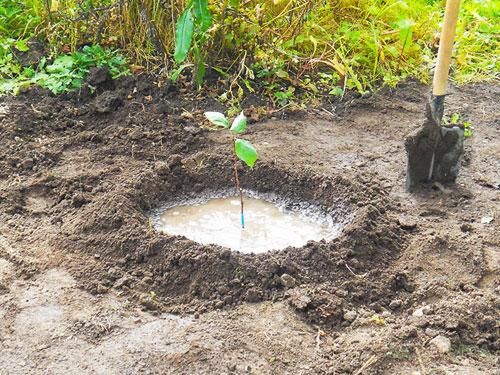

The autumn feeding procedure for the columnar peach should be done with a 10% urea solution. Rotten manure and bird droppings are also suitable for these purposes.
Watering
Moisten the soil in the near-trunk circle as the top layer dries. Water consumption per planting is 10-20 liters. For better aeration, the soil must be loosened after each irrigation; oxygen starvation of the root system of the columnar peach must not be allowed.
Pruning
With spring and autumn pruning of a columnar peach, all incompetent shoots with traces of diseases are removed. Fruit trees should be pruned before sap flow begins. Manipulations with the removal of dry and damaged shoots contribute to the growth of new branches, high productivity rates, and a decrease in the likelihood of developing diseases. It is recommended to shorten the shoots by 15-20 centimeters annually.


What is Columnar Peach
Column peach is an ornamental tree that fits perfectly into the landscape of any garden, brings a good harvest and does not require much attention - these bonuses primarily attract gardeners. Well, the luminaries of gardening need such a culture for the sake of exoticism and diversity. In fact, a columnar peach is a short tree - no more than 1.4–1.6 m, forming a crown in the form of a cylinder or column.
But there is one thing: the columnar fruit trees are currently officially represented only in one culture - the apple tree, as experts in this field say with full responsibility. The apple tree forms a column due to its low branching, the fruits on the columnar apple trees are tied directly to the trunk.
In 1964, an apple tree was found in Canada without side branches, but with more fruits right on the trunk. This feature of the development of the apple tree was attributed to a mutation and tried to reproduce, apparently, quite successfully. And still this type of fruit formation occurs only on apple trees, with other fruit trees the "focus" does not work - already in the 3-4th year the seedlings with fruits on the trunks, if this is still achieved, turn into ordinary trees, the height of which exceeds 2 m, and fruiting occurs only on well-developed long shoots of the second year. Even if it is possible to create a semblance of a "column" on a peach, plum, cherry, then only by shortening the fruitful shoots. This achieves the fruiting effect on the trunk - visual columnarity.
Video: the whole truth about the columnar peach
Columnar varieties of fruit trees are represented by undersized cultivars, while they bear fruit abundantly - if we take into account the total area of fruiting shoots, then 4–6 kg from one columnar tree will be quite a worthy harvest. Plants with this type of crown are evaluated mainly according to the following parameters:
- trees take up little space - comparable to a two-year-old sapling of any garden culture;
- high winter hardiness, besides, dwarf trees in the form of a column are easy to cover, therefore they are often recommended for forcing in a harsh climate;
- good survival rate of a thermophilic culture;
- excellent taste of fruits and large-fruited - for columnar varieties of peach, it is not uncommon for fruits to weigh up to 200 g or more, and harvesting is not at all difficult - fragrant fruits are at most at arm's length;
- uncomplicated pruning;
- a tree needs only 10-15 liters of water with a one-time watering, while a tall peach at the time of fruiting requires at least 3-5 buckets of water (30-50 liters), it is also easier to feed and loosen the ground for a columnar peach - a trunk circle and a radius the trunk is smaller than that of ordinary peach trees;
- processing of columnar peaches is also simplified - a 1.5-meter tree is much easier to spray than a giant 2-3 meters tall.
What pitfalls await farmers who have decided to grow columnar peaches:
- in comparison with classic varieties of peach, the columnar has a low yield due to the small size of the tree;
- short life span - 5–7 years;
- high price of seedlings.
But other disadvantages of this type of culture cannot be ruled out, the most obvious is that not a single amateur gardener has provided evidence of the stunning results of growing columnar peaches in practice for a long time. So far, you can only find offers in online stores to buy seedlings of such a peach. But there are also no details on the care of such a tree, fruiting trends over the next 3-5 years after planting, and there is no evidence of an annual high yield of columnar peaches without effort either.
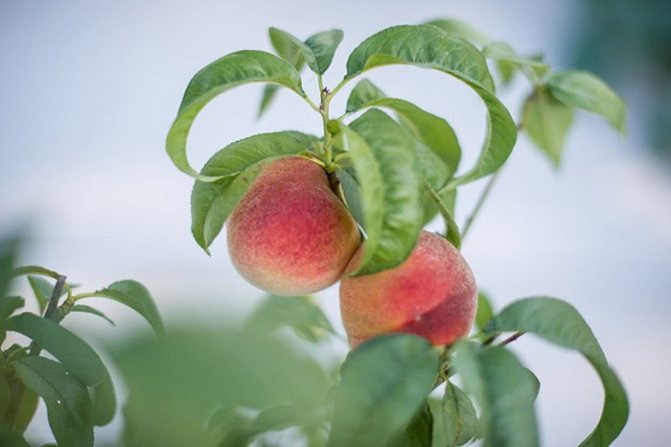

Real photos of columnar peaches with fruits are almost impossible to find, but there is a lot of photoshop on the Internet - a reason to think about the truth about columnar peaches
It is believed that dwarf fruit tree varieties were created for forcing in intensive orchards, replacing seedlings there every 5-7 years. And columnarity, in particular on an apple tree, is achieved by spurism, when, as a result of vegetative crossing, internodes on the shoots are shortened. Sometimes the fruit buds are so close together that when the crop ripens, the effect of crowding is created - the fruits are located tightly, as if along the trunk - on a short-growing tree with a short pruning, we see the effect of the fertility of a columnar culture.
Growing columnar peaches is not the best idea for those who want a high return from the peach and are not inclined to plant new trees in the garden every 4-5 years. Moreover, most often it is a deception of Internet scammers, an outrage on the imagination of inexperienced gardeners. I agree that a columnar orchard from a series of "weaving strawberries" can be planted, but the result is unpredictable - it is hardly possible to get a decent harvest from one trunk of a peach tree. But to grow such a tree as an exotic tub culture is surprising to the guests and to admire the enchanting flowering of pink peach buds is easy. I would rather attribute the columnar peach not to the category of fruit trees, but to ornamental shrubs. And striving for high yields of columnar peaches is like trying to collect 3 buckets of barberry berries from a bush.
Diseases and pests
Among the frequent ailments that affect the columnar peach, they note: fungal diseases, clasterosporia, curly leaves. It is possible to prevent the development of diseases by carrying out preventive measures, using copper sulfate 3% for processing.
The procedure is repeated again until the kidneys awaken. Before the flowering phase, Horus, Speed, Strobi are used. Appropriate insecticides (Akarin, Fitoverm) should be used against aphids, ticks, weevils. Pruning makes trees hardy and resistant to adverse environmental factors.
Columnar peach is a great solution for a small garden. The main thing is not to violate the rules of agricultural technology and plant healthy planting material.
Preparing the soil and seedling for planting
Annual seedlings are best suited for planting in the soil. The survival rate and yield in a new place of mature trees are worse than those of young plants. The soil begins to be prepared in the autumn. Weeds are removed from the place for seedlings, garbage is removed. Lumps of rotted humus are scattered around the site, then the soil is carefully dug up.
In the spring, holes are dug half a meter deep and 60 centimeters in diameter. Ash (one glass), potash fertilizers are scattered into each hole. A good seedling has a developed root system, a pronounced graft mark. It is better not to choose trees with rot, diaper rash, breaks on the roots.
Choosing a landing site
The best area for planting a seedling is a well-lit area with fertile soil (black earth or garden soil) of neutral acidity. The ideal option is the south side of the site. The shadow of neighboring buildings and trees should not fall on the place for the peach hole. Swampy soils are not suitable for columnar varieties.
Due to their excellent decorative qualities, as well as their compactness, peaches are often planted in front of the house or in the front garden. The trees are combined with various elements of landscape design, small architectural forms.
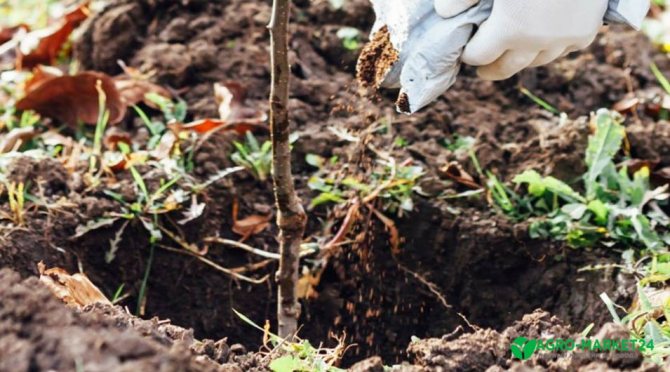

Planting a columnar peach: detailed recommendations
During planting, a certain order of actions should be followed.
1
... The soil from the pit is mixed with manure (one bucket) and superphosphate (300 grams).
2.
The prepared soil is poured into the hole to the middle, with a small slide.
3.
The seedling is immersed in the hole, parts of the roots are neatly and evenly distributed over the embankment.
4.
The hole is covered with earth. Every 5-10 centimeters, the layer is tamped a little to prevent voids.
5.
A trunk circle is formed around the plant - a small embankment with a radius of 25 centimeters.
6.
The seedling is watered with water (10 liters).
Due to their high winter hardiness, columnar varieties are grown in the southern regions, the middle lane, for example, the Moscow region, and in the northern regions. In the North, trees are planted at an angle of 45 degrees in places protected from the winds. Such a slope is optimal for shelter for the winter with a non-woven material, which is covered with spruce branches on top.
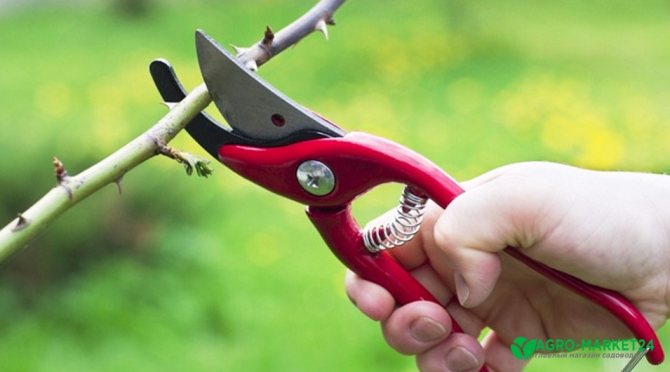

Column Peach Care
The plant is not fertilized for the first two years.
- enough minerals introduced into the soil during planting. From the third year,
in the spring
and
in summer
, you need to make complex mineral fertilizers.
In autumn
it is best to use organic matter (manure, chicken droppings), superphosphate additives.
When plants bloom for the first time, experienced gardeners pluck the buds so that the seedlings develop and gain strength. When necessary, the soil is watered; ten to twenty liters of water are consumed per tree. After irrigation or rain, it is necessary to loosen the root circle. IN autumn and spring
pruning is carried out for months, damaged, drying shoots are removed.
>
Pros and cons of the variety
One of the main and indisputable advantages of this peach variety is its small growth and compactness. Thanks to this feature, planting and caring for such a plant is easy. And there is no need for crown formation using a procedure such as pruning. At the same time, the quality of the peaches being picked is at the highest level.
As for the disadvantages of this variety, they include a low yield due to a small crown and a short life of the tree. As a result, the plantings of this variety must be constantly updated.
Another disadvantage is the high cost of the columnar seedling. Therefore, gardeners often make a choice in favor of other peach varieties, with a more attractive cost per seedling.
